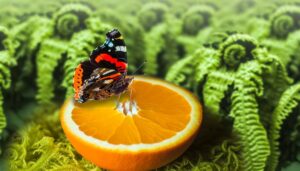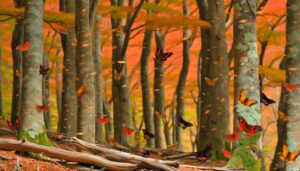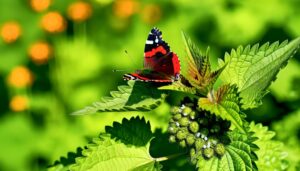3 Human Foods That Attract Red Admiral Butterflies
The Red Admiral butterfly is attracted to human foods rich in sugars and undergoing fermentation. Particularly, fruit juices, overripe bananas, and fermented fruits like apples and pears are highly appealing due to their natural sugars and ethanol content.
Additionally, sugary beverages, such as soft drinks and fruit juices, offer immediate energy sources. The butterflies also show a marked preference for alcoholic beverages like beer and wine, which mimic natural fermenting fruits.
Sweet baked goods and rotting vegetables can similarly attract these butterflies, providing essential nutrients and diverse dietary options. Understanding these preferences can enhance butterfly conservation efforts.
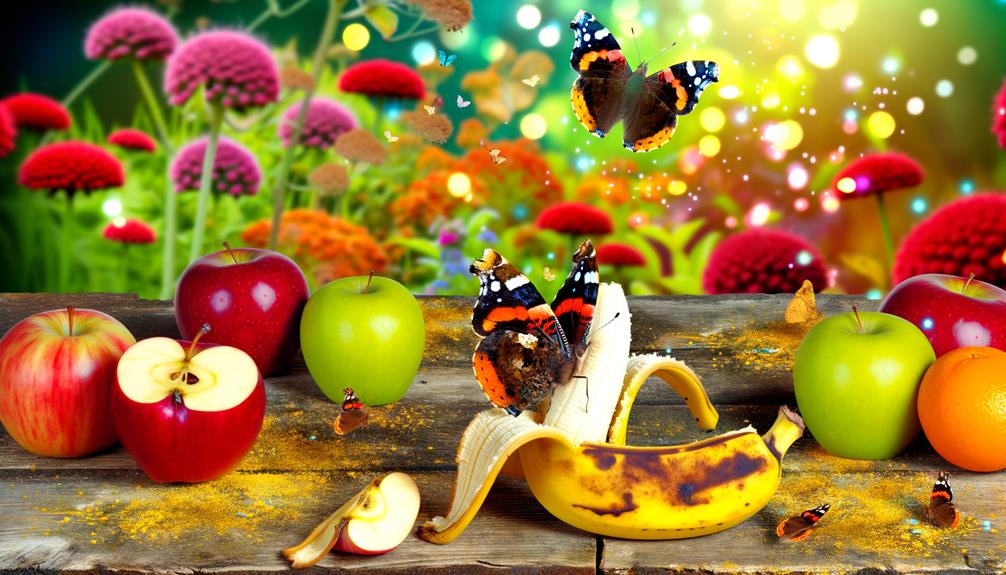
Key Takeaways
- Red Admiral butterflies are attracted to overripe bananas due to their high fermenting sugar concentration.
- They frequently feed on sugary beverages like fruit juices and sodas for their high glucose and fructose content.
- The butterflies are drawn to human-made alcoholic beverages like beer and wine because of the ethanol produced during fermentation.
- Rotting vegetables such as tomatoes, cucumbers, and squash attract them due to the release of volatile organic compounds.
Fruit Juices
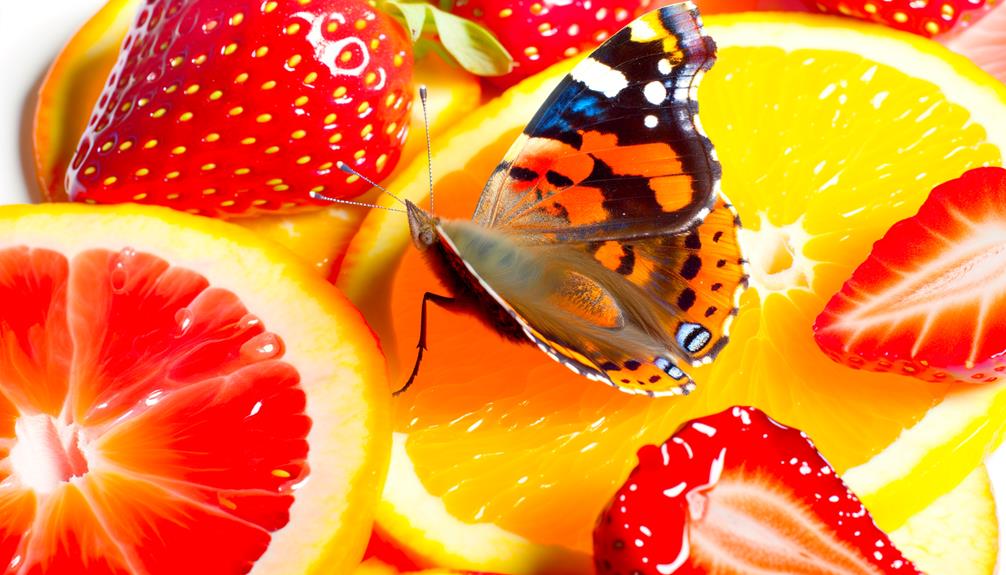
Red Admiral butterflies (Vanessa atalanta) demonstrate a notable attraction to fruit juices, which serve as a significant supplementary food source, particularly during periods of nectar scarcity.
These juices provide essential carbohydrates and micronutrients that support their metabolic needs. The butterflies exhibit a preference for naturally occurring sugars found in various fruits such as oranges, apples, and pears.
This dietary flexibility allows them to sustain energy levels and maintain proper physiological functions. The enzymatic breakdown of fruit sugars into simpler forms facilitates easier absorption and utilization.
Consequently, fruit juices not only supplement their diet but also enhance their resilience in fluctuating environmental conditions, ensuring their survival and reproductive success amidst varying nectar availability.
Overripe Bananas
In addition to fruit juices, overripe bananas serve as an essential food source for Red Admiral butterflies, providing a rich concentration of fermenting sugars that are readily accessible and metabolizable.
These sugars undergo a fermentation process, resulting in the production of ethanol, which is particularly attractive to the butterflies. The high sugar content in overripe bananas offers a quick energy source, facilitating the butterflies' metabolic processes and flight activities.
Moreover, the soft texture of overripe bananas simplifies ingestion, allowing the butterflies to feed efficiently through their proboscis. This accessibility guarantees that Red Admiral butterflies can easily meet their nutritional requirements, promoting their survival and reproductive success.
Consequently, overripe bananas are a highly effective attractant for these lepidopterans.
Fermented Fruits
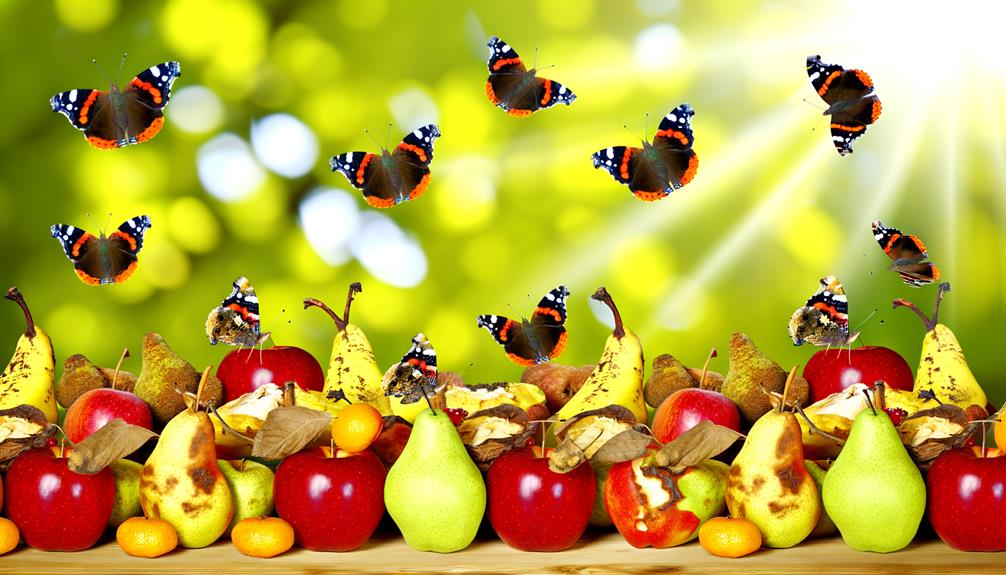
Red Admiral butterflies exhibit a preference for fermented fruits such as apples and pears due to the high ethanol content, which provides an easily accessible energy source.
The nutritional benefits of these fermented fruits include essential sugars and vitamins, which are critical for the butterflies' metabolic processes and overall health.
This dietary inclination towards fermented produce highlights the intricate relationship between insect feeding behaviors and the nutritional composition of their food sources.
Preferred Fermented Fruits
Fermented fruits, particularly those undergoing natural fermentation processes, are highly preferred by the Red Admiral Butterfly due to the elevated ethanol content that attracts and sustains them. These butterflies are often observed flocking to overripe and decomposing fruits, where natural fermentation produces ethanol, a potent attractant. The following table outlines some commonly preferred fermented fruits:
| Fruit Type | Ethanol Production Level | Attractiveness to Red Admiral |
|---|---|---|
| Overripe Bananas | High | Very High |
| Fermenting Apples | Moderate | High |
| Rotting Peaches | High | Very High |
| Decaying Plums | Moderate | High |
This table demonstrates the correlation between ethanol production levels and the attractiveness of specific fermented fruits to the Red Admiral Butterfly, underscoring their preference for high-ethanol environments.
Nutritional Benefits
The nutritional benefits of fermented fruits for the Red Admiral Butterfly are primarily derived from the enhanced availability of sugars and essential nutrients released during the fermentation process.
Fermentation breaks down complex carbohydrates and proteins, transforming them into simpler sugars and amino acids that are more readily absorbed by the butterfly. This biochemical conversion increases the concentration of glucose, fructose, and essential micronutrients such as vitamins and minerals.
Additionally, the ethanol produced during fermentation acts as an attractant and energy source, facilitating prolonged feeding periods.
These enhanced nutritional profiles contribute to improved wellness, reproductive success, and increased longevity in the Red Admiral Butterfly.
Consequently, fermented fruits represent an important dietary component, optimizing the butterfly's metabolic efficiency and overall health.
Sugary Beverages
Red Admiral butterflies exhibit a notable attraction to sugary beverages, particularly fruit juices and sodas, due to their high glucose and fructose content.
This affinity can be attributed to the similar sugar profiles found in the nectar of flowers, their primary food source.
Observations indicate that the consumption of these human-provided sugary liquids can influence their feeding behavior and energy levels.
Fruit Juices Appeal
Attracted by the high sugar content, red admiral butterflies frequently seek out fruit juices as a dietary supplement. These butterflies exhibit a distinct preference for natural, unprocessed fruit juices due to their rich glucose and fructose composition. The following table outlines various types of fruit juices and their typical sugar content, creating a useful reference for understanding the butterflies' attraction:
| Fruit Juice Type | Sugar Content (g/100ml) | Attraction Level |
|---|---|---|
| Apple Juice | 10.0 | High |
| Orange Juice | 9.0 | High |
| Grape Juice | 15.0 | Very High |
| Pineapple Juice | 13.0 | Very High |
| Mango Juice | 12.0 | High |
The high sugar levels in these juices provide essential energy, supporting the butterflies' active lifestyle and migratory patterns.
Soda Attraction
While natural fruit juices are a well-known dietary preference for red admiral butterflies, sugary beverages such as sodas also attract these insects due to their high glucose and fructose content.
The sugars present in sodas provide an immediate energy source, which is essential for the butterfly's metabolic processes and flight activities.
The attraction is primarily due to the olfactory and gustatory receptors that detect the sweetness, mimicking the sugars found in their natural diet.
The high sugar concentration in sodas can lead to increased visitation by red admirals in areas where these beverages are discarded or spilled.
Consequently, understanding this attraction can be pivotal for both butterfly conservation efforts and managing human waste to reduce unintended ecological impacts.
Beer and Wine

Entomological studies have documented that the Red Admiral butterfly (Vanessa atalanta) is often drawn to fermenting fruits, which can subsequently lead to their attraction to human-made alcoholic beverages such as beer and wine.
The fermentation process releases ethanol and various volatile organic compounds, mimicking the butterflies' natural food sources. These chemicals act as olfactory cues that lure the Red Admirals.
Additionally, the sugars present in beer and wine provide an energy-rich food source, essential for their metabolic activities.
Field observations and controlled experiments have confirmed that Vanessa atalanta exhibits a marked preference for these substances, especially during periods of food scarcity.
Understanding this behavior can inform both conservation efforts and strategies for managing butterfly populations in human-impacted areas.
Rotting Vegetables
Red Admiral butterflies (Vanessa atalanta) are frequently observed feeding on rotting vegetables, which release an array of volatile organic compounds similar to those found in fermenting fruits. These compounds include esters, alcohols, and aldehydes, which mimic the natural attractants of the butterflies’ preferred diet. This feeding behavior helps sustain Red Admiral butterflies when fresh nectar sources are scarce, particularly in late summer and early fall. In addition to rotting vegetables, they are also drawn to certain flowering plants, such as the 3 thistle types for butterflies, which provide essential nectar and serve as key foraging sites. These thistles, along with other nectar-rich plants, support butterfly populations by offering alternative food sources throughout their life cycle.
The decomposition process breaks down complex carbohydrates and proteins, producing a nutrient-rich substrate that appeals to the butterflies. Additionally, the moisture content in rotting vegetables facilitates easier ingestion and digestion for these insects.
Field observations have shown that Red Admirals are particularly drawn to decomposing vegetables like tomatoes, cucumbers, and squash. This affinity suggests that rotting vegetables serve as a significant supplementary food source, especially when traditional nectar sources are scarce.
Sweet Baked Goods
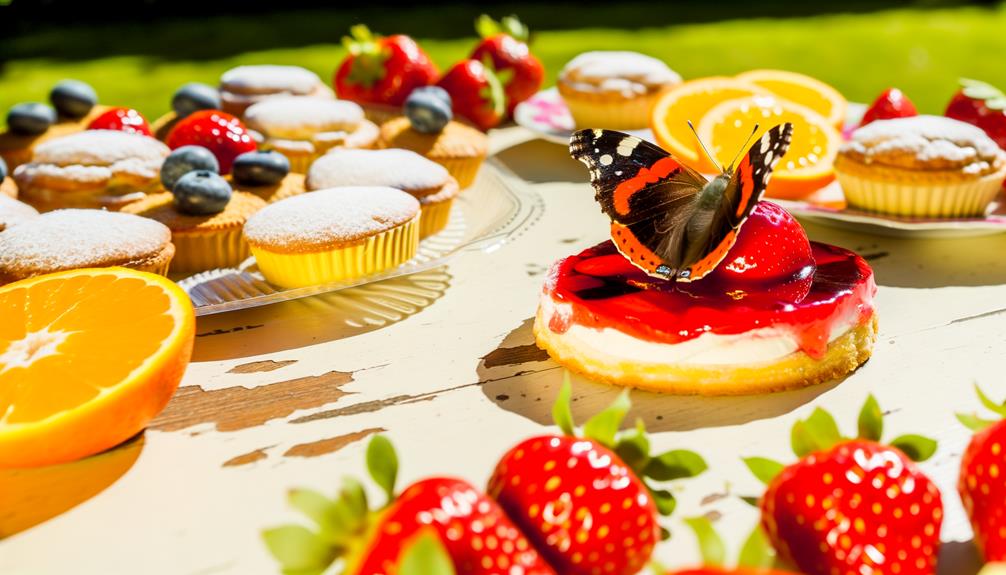
Sweet baked goods, such as pastries and cakes, attract Red Admiral butterflies due to their high sugar content and similar volatile compounds found in fermenting fruit.
These compounds include ethanol and other aromatic esters, which mimic the chemical signals the butterflies rely on to locate food sources in their natural habitat.
The sugars in these baked goods provide an immediate energy source, essential for their high metabolic demands during flight.
Additionally, the soft texture enables easy feeding through their proboscis.
This attraction underscores the butterfly's opportunistic nature, exploiting available resources beyond typical floral nectar.
Understanding these interactions can aid in designing butterfly-friendly environments and further studies on insect behavior related to anthropogenic food sources.
Conclusion
The Red Admiral butterfly exhibits a distinct attraction to various human foods, including fruit juices, overripe bananas, fermented fruits, sugary beverages, beer, wine, rotting vegetables, and sweet baked goods.
This preference is likely driven by the high sugar content and fermentative properties of these items, providing essential nutrients and energy.
An anticipated objection regarding potential harm from human foods is mitigated by the butterfly's natural inclination towards similar fermenting substances in its environment, ensuring compatibility with its dietary needs.


